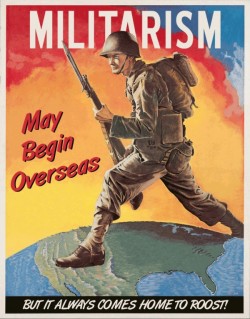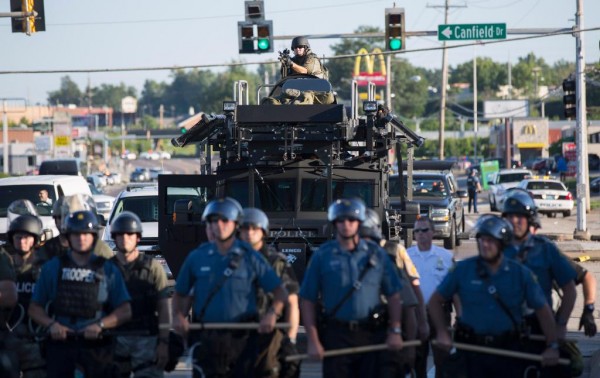WASHINGTON POST: The events these last few days in Ferguson, Missouri ought to be of grave concern to anyone who believes in the First Amendment, and specifically the rights to free speech, protest, and assembly. As you may have read, last night was particularly ugly, as police arrested a St. Louis alderman, Huffington Post reporter Ryan J. Reilly, and our own Washington Post reporter Wesley Lowery. Police also tear-gassed a news crew from Al-Jazeera. There are also reports, video, and images of police teargassing, arresting, and otherwise intimidating peaceful protests all over the town. MORE
NEW YORKER: Nothing that happened in Ferguson, Missouri, on the fourth night since Michael Brown died at the hands of a police officer there, dispelled the notion that this is a place where law enforcement is capable of gross overreaction. Just after sundown on Wednesday, local and state officers filled West Florissant Avenue, the main thoroughfare, with massive clouds of tear gas. They lobbed flash grenades at protesters who were gathered there to demand answers, and, at times, just propelled them down the street. That they ordered the crowd to disperse was not noteworthy. That the order was followed by successive waves of gas, hours after the protests ended, became an object lesson in the issues that brought people into the streets in the first place. Two journalists, Wesley Lowery, of the Washington Post, and Ryan Reilly, of the Huffington Post, and a St. Louis Alderman, Antonio French, were arrested. (The journalists were let go without charges; the alderman, as his wife told reporters, was released after being charged with unlawful assembly.) What transpired in the streets appeared to be a kind of municipal version of shock and awe; the first wave of flash grenades and tear gas had played as a prelude to the appearance of an unusually large armored vehicle, carrying a military-style rifle mounted on a tripod. The message of all of this was something beyond the mere maintenance of law and order: it’s difficult to imagine how armored officers with what looked like a mobile military sniper’s nest could quell the anxieties of a community outraged by allegations regarding the excessive use of force. It revealed itself as a raw matter of public intimidation.
Whatever happened to Michael Brown in the moments before he died has become secondary to what the response to his death has revealed. The name of the officer who shot him remains unknown. Even the  number of times that Brown was shot has not been disclosed, despite the completion of a preliminary autopsy. Jon Belmar, the St. Louis County Chief of Police, justified withholding the officer’s name by citing a deluge of threats against the department and noting that he has not been charged with a crime. In the same press conference, Belmar released the name of a nineteen-year-old young man who was shot in the head by a police officer during the previous night, who Belmar said brandished a firearm during a protest. The young man remains in critical condition, but, if he survives, he will be charged with felony assault of a police officer. Belmar stated that he saw no reason to doubt the officer’s version of the events.
number of times that Brown was shot has not been disclosed, despite the completion of a preliminary autopsy. Jon Belmar, the St. Louis County Chief of Police, justified withholding the officer’s name by citing a deluge of threats against the department and noting that he has not been charged with a crime. In the same press conference, Belmar released the name of a nineteen-year-old young man who was shot in the head by a police officer during the previous night, who Belmar said brandished a firearm during a protest. The young man remains in critical condition, but, if he survives, he will be charged with felony assault of a police officer. Belmar stated that he saw no reason to doubt the officer’s version of the events.
Two days earlier, the police department had pledged to investigate Brown’s death while simultaneously stating that the shooting was the result of a struggle in which Brown allegedly went for an officer’s weapon. They had, at that point, not interviewed the witnesses who claimed that Michael Brown was shot down while running away or attempting to surrender. Inside of a week, two black teen-agers have been shot by police and, in both instances, the bureaucratic default setting has favored law enforcement, fuelling a perception that the department is either inept or beholden to a certain nonchalance about the possibility of police brutality. Late in the afternoon on Wednesday, the armored vehicles rolled into place just beyond the charred shell of the QuikTrip gas station that was burned on the first night of protests. Police, some outfitted in riot gear, others in military fatigues, barricaded the streets. At least one of them draped a black bandana over his face; others covered their badges. […] Ten minutes later, the sound of breaking glass was heard and the police demanded that the crowd disperse. Only seconds after that I saw a half-dozen canisters launch into the air and the streets were bathed in the strobe lights of flash grenades. […] The day began with questions about why a young man was killed just days before he was due to begin college. It ended as a referendum on the militarization of American police forces. MORE
PREVIOUSLY: At Long Last, The Perma-War Comes Home As American Turns The Machinery Of War Against Its Own People
PREVIOUSLY: Pentagon Preparing For Mass Civil Breakdown By Criminalizing Peaceful Dissent

